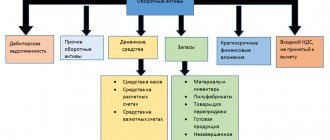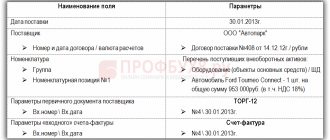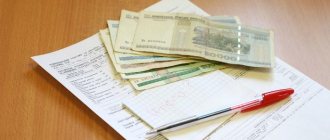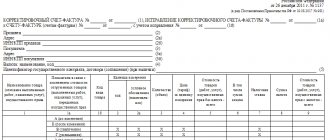General rules for deducting VAT on fixed assets
The amount of VAT paid by an enterprise when purchasing fixed assets or equipment for use in production activities is legally allowed to be fully deducted. It is possible to deduct VAT on fixed assets by observing the provisions set out in paragraph 2 of Art. 171 Tax Code of the Russian Federation, clause 1, art. 172 of the Tax Code of the Russian Federation and Art. 169 of the Tax Code of the Russian Federation. It is allowed to deduct VAT on fixed assets if:
- The objects were acquired for use in the activities of the enterprise subject to VAT.
- Objects are registered as fixed assets, for which there is documentary evidence, for example, acceptance certificates (OS-1).
- The VAT amount is confirmed by an invoice issued accordingly.
For some reasons for refusal to deduct VAT, see our material “What is the procedure for applying (accepting) tax deductions for VAT: conditions?”
Is it possible to deduct VAT on fixed assets that have not been put into operation? The answer to this question, as well as some of the nuances of filing a VAT deduction, were explained by ConsultantPlus experts. If you do not have access to the K+ system, get a trial online access for free.
On the deduction of VAT on the acquisition of fixed assets
Situation:
The fixed assets were purchased at a high cost and will be used in activities subject to VAT. All conditions for acceptance for deduction, according to the Tax Code, have been met. We can immediately deduct VAT from the cost of fixed assets, but how best can we do this and with what are the least tax risks?
1) We accept VAT for deduction on the basis of an issued invoice; at the moment the OS is accepted for accounting (all conditions for accepting VAT are met), we have a decent amount of VAT in our tax return for reimbursement from the Federal Tax Service.
Can we show it for reimbursement, but not ask for it to be returned to us, but count it towards the payment of future tax periods for VAT?
Or VAT is a tax where the billing period is a quarter, i.e. in this quarter VAT is deductible, which means it must be returned to us, in the next quarter we show it for payment, which means we pay, it’s impossible to count quarterly calculations?
2) Do we have the right to deduct this VAT for three years? For example, after a year we have enough accrued VAT and we will deduct VAT on the accepted operating system, and there will be no refund?
3) We will be able to deduct VAT in the tax return partially (according to one invoice issued for the purchased OS) during what period, for example, a year?
Answer:
Option 1.
If the conditions for applying the deduction are met (i.e. the requirements of clause 2 of Article 171, clause 1 of Article 172 of the Tax Code of the Russian Federation are met, an invoice is available, the OS has been capitalized, the OS is planned to be used in transactions subject to VAT), the taxpayer has the right to claim VAT as a deduction, even if he did not have taxable transactions during the tax period (Letter No. ED-3-3 dated 02/28/2012/ [email protected] ).
We note that in these clarifications, the regulatory authorities recommend that taxpayers be guided by the position set forth in Resolution of the Presidium of the Supreme Arbitration Court of the Russian Federation dated May 3, 2006 No. 14996/05. The judges of the Supreme Arbitration Court of the Russian Federation noted that the norms of Ch. 21 of the Tax Code of the Russian Federation does not establish the dependence of deductions for purchased goods (work, services) on the actual calculation of tax for specific transactions for which these goods (work, services) were purchased. A similar opinion is expressed by lower courts (Resolutions of the Federal Antimonopoly Service of the North-Western District dated June 16, 2011 No. A56-60826/2010, FAS Moscow District dated September 1, 2011 No. KA-A41/9789-11, FAS Volga District dated June 24, 2011 No. A65-24305 /2010).
At the same time, it is necessary to keep in mind that the Ministry of Finance of Russia recommended that the tax authorities pay special attention to those cases when the taxpayer declares large amounts of VAT to be deducted in the absence of a tax base in the tax period (Letter dated November 19, 2012 No. 03-07-15/ 148 (sent for information and use in work by Letter of the Federal Tax Service of Russia dated December 7, 2012 No. ED-4-3 / [email protected] ).
Conclusion:
You have the right to refund VAT in the quarter when the invoice is received, at the time the OS is accepted for accounting. The resulting VAT overpayment will be taken into account in subsequent tax periods. You will even have the right to return the overpaid VAT to your bank account. There is a risk (Letter of the Federal Tax Service of Russia dated December 7, 2012 No. ED-4-3 / [email protected] ) that, based on the results of a desk audit, your right to a VAT refund will be denied and you will have to defend this right in court.
Option 2.
Deductions of tax amounts presented by sellers to the taxpayer upon acquisition of fixed assets are made in full after the registration of these fixed assets (clause 1 of Article 172 of the Tax Code of the Russian Federation).
From 01/01/2015, such tax deductions can be claimed in tax periods within three years after the registration of fixed assets acquired by the taxpayer (clause 1.1 of Article 172 of the Tax Code of the Russian Federation).
However, even before this, the Plenum of the Supreme Arbitration Court of the Russian Federation believed that the taxpayer has the right to take advantage of tax deductions in a later tax period within three years after the end of the quarter in which the right to deduction arose (paragraphs 27, 28 of the Resolution of the Plenum of the Supreme Arbitration Court of the Russian Federation dated May 30, 2014 No. 33 “On some issues that arise in arbitration courts when considering cases related to the collection of value added tax”). This point of view was also expressed by the Russian Ministry of Finance (Letter dated January 24, 2013 No. 03-07-11/19).
As for the right to deduct VAT on fixed assets, then, according to the FAS Moscow District, it arises from the moment the fixed assets are accepted for accounting on account 01. And the earlier date of issuing the invoice by the seller of the fixed assets does not have any significance (Resolution of the FAS Moscow District dated 07/20/2012 No. A40-108719/11-90-455).
As the Constitutional Court of the Russian Federation indicated in paragraph 2.2 of the Determination of March 24, 2015 No. 540-O, the date of occurrence of the obligation to pay VAT, the amount of which is determined taking into account the declared tax deductions, is the end date of the tax period, and not the date of submission of the tax return.
Conclusion:
You have the right to take into account VAT for reimbursement at a later period within a three-year period. If the accrued VAT indicated in the tax return exceeds the VAT to be refunded, then this refund option is the most problem-free.
Option 3.
The amount of VAT on fixed assets for the production of products subject to VAT is subject to tax deduction based on an invoice received from the seller (clause 1, clause 2, article 171, paragraph 1, 2, 3, clause 1, article 172, clause 1 Article 169 of the Tax Code of the Russian Federation).
Based on clause 1.1 of Art. 172 of the Tax Code of the Russian Federation, starting from January 1, 2015, it is possible to claim VAT deductions within three years after registration of purchased goods, works and services. That is, an organization has the right to transfer and divide VAT deductions for one invoice into several quarters. However, this rule does not apply to all deductions.
Regarding the deduction of VAT in parts on one invoice when purchasing fixed assets from financiers and from courts, opinions are opposite. Paragraph 3, paragraph 1, art. 172 of the Tax Code of the Russian Federation they interpret differently.
According to the Russian Ministry of Finance, an organization has the right to split VAT deductions only from purchases of goods, works, and services. Deduction of “input” VAT on fixed assets and intangible assets is made in full after the object is registered. Such clarifications are contained in Letters of the Ministry of Finance of Russia dated 04/09/2015 No. 03-07-11/20293 and 03-07-11/20290.
The courts believe that “in full” means that the entire amount of VAT is subject to deduction and this can be done in different tax periods within three years. In the Resolution of the Arbitration Court of the Volga District dated June 10, 2015 in case No. A12-38088/2014, the court indicated that VAT can be deducted not only at once during the period of acceptance of the fixed asset for accounting, but also in parts within a three-year period. The court had come to this conclusion before and allowed the deduction for one asset to be split into different quarters (Resolution of the Federal Antimonopoly Service of the Moscow District dated April 22, 2011 No. KA-A40/1659-11).
Conclusion:
Considering the official position of the Russian Ministry of Finance, splitting the VAT deduction for an acquired fixed asset into one invoice is risky; the deduction will most likely be denied. At the same time, the organization has a great chance of defending its position in court.
Moment of deduction of VAT on fixed assets
The peculiarity of accepting a VAT deduction on fixed assets lies in the correct determination of the moment of this operation. One of the conditions for presenting tax for deduction, according to paragraph 1 of Art. 172 of the Tax Code of the Russian Federation, is to register an object as a fixed asset. But the Tax Code of the Russian Federation does not have clear characteristics on the basis of which an object can be accepted for accounting as a fixed asset. Therefore, the question of the moment of deduction is not clear-cut.
Thus, initially the regulatory authorities insisted that when purchasing fixed assets, VAT deduction is possible only after the property is reflected in account 01 “Fixed assets” (see, for example, letters of the Ministry of Finance of the Russian Federation dated 02.12.2015 No. 03-07-11/6141, dated 24.01 .2013 No. 03-07-11/19). Later, the position of the Ministry of Finance changed - see “Deduction for fixed assets on account 08 is not a problem.” Now officials consider it possible to accept VAT for deduction within 3 years after entry into account 08 (letter of the Ministry of Finance dated 04/11/2017 No. 03-07-11/21548).
Judicial practice proceeds from the fact that the account into which fixed assets are accepted for accounting does not matter. The thing is that in accounting, acquired property goes through several stages of being reflected in accounting before becoming a fixed asset. Transactions for the purchase of property are initially reflected in account 08 “Investments in non-current assets”. The transfer of an object to 01 account is carried out only after its initial value has been fully formed. Therefore, if the taxpayer decides to receive a deduction for fixed assets placed on account 08, then there is a possibility of a dispute with the tax authorities. However, there is a good chance of defending your point of view in court.
For more information about the arguments, see our material “What is the procedure for deducting VAT when purchasing fixed assets?”
01 invoice required for deduction
For a long time, tax authorities and the Russian Ministry of Finance unanimously argued that the right to deduction appears after property is reflected in account 01. Officials explained their position with the following arguments.
Deductions of VAT amounts presented by sellers to the taxpayer upon acquisition of fixed assets are made in full after the registration of these objects. This rule is established by paragraph 1 of Art. 172 of the Tax Code of the Russian Federation.
According to the Chart of Accounts, the generated initial cost of fixed assets accepted for operation and registered in the prescribed manner is taken into account on account 01 “Fixed Assets”. The accounting unit for fixed assets is an inventory item, which is assigned the corresponding inventory number (PBU 6/01).
It is allowed to accept for accounting as fixed assets with allocation on a separate sub-account to account 01 real estate objects for which:
- capital investments have been completed;
- the corresponding primary accounting documents for acceptance and transfer have been drawn up;
- documents have been submitted for state registration;
- objects actually in operation.
About this - in paragraph 52 of the Methodological guidelines for accounting of fixed assets, approved by Order of the Ministry of Finance of Russia dated October 13, 2003 N 91n. Thus, fixed asset objects are considered registered in the tax period in which the primary accounting documents confirming the date the object was put into operation were drawn up.
Consequently, deductions of “input” VAT amounts when purchasing a fixed asset, accepted for accounting as an independent inventory item, are made in the tax period in which the following conditions are simultaneously met:
- accepting an object for registration as a fixed asset;
- availability of an invoice for this object, drawn up in accordance with the requirements provided for in paragraphs 5 and 6 of Art. 169 of the Tax Code of the Russian Federation.
In this regard, in the case of the acquisition of fixed assets, tax deductions are made after they are registered as fixed assets, that is, to account 01 “Fixed assets”.
You will find such explanations in Letters of the Ministry of Finance of Russia dated October 28, 2011 N 03-07-11/290, dated August 2, 2010 N 03-07-11/330, dated September 21, 2007 N 03-07-10/20.
Tax officials express a similar opinion (Letters of the Federal Tax Service of Russia dated 04/05/2005 N 03-1-03/530/ [email protected] , Federal Tax Service of Russia for Moscow dated 10/02/2007 N 19-11/093494).
It should be noted that there are court decisions supporting this position. Thus, in Resolution dated February 22, 2012 N A40-56010/11-91-242, the Moscow District Federal Antimonopoly Service indicated that the company had the right to deduct after putting objects into operation and transferring them from account 08 “Investments in non-current assets” to account 01 "Fixed assets". It is at this moment that the conditions established by Art. Art. 171, 172 of the Tax Code of the Russian Federation, to submit VAT for deduction:
- there were invoices;
- fixed assets are registered;
- facilities have been put into operation;
- their use has begun to carry out transactions subject to VAT.
The same conclusions are contained in the Resolution of the Federal Antimonopoly Service of the Volga Region dated September 30, 2010 N A12-24919/2009.
VAT deduction on fixed assets requiring installation
For objects that require installation to bring them into working condition, the law allows for deduction of tax paid to third-party organizations performing work on the assembly or installation of objects, as well as suppliers of equipment and materials used in installation work. This is clearly stated in paragraph 6 of Art. 171 Tax Code of the Russian Federation.
Assets requiring installation and assembly are initially recorded in accounting account 07 “Equipment for installation” with further debiting to account 08 as the equipment is transferred for installation. Capitalization to account 01 occurs only after the assembled objects are completely ready for use. In this case, it is allowed to deduct “input” VAT already at the time the object is reflected on account 07 (letter of the Ministry of Finance of Russia dated January 29, 2010 No. 03-07-08/20).
08 invoices are enough for deduction
Recently, the Russian Ministry of Finance changed its position regarding the accounting of objects for the purpose of applying the value added tax deduction. True, the Department's Letter in question concerns a fixed asset that will be accepted into account 01 after reconstruction. But nevertheless, Letter of the Ministry of Finance of Russia dated July 16, 2012 N 03-07-11/185 should not be ignored.
So, the Russian Ministry of Finance considered the following situation. The company accepted real estate assets into account 08 “Investments in non-current assets”. These assets were acquired for the purpose of their further reconstruction and use in activities subject to value added tax. The taxpayer has a question: at what point does he have the right to accept “input” VAT as a deduction?
Financiers explained that the right to deduction appears after the property is reflected in account 08.
Officials recalled that tax amounts presented to the taxpayer for goods purchased by him, including for construction and installation work, are subject to deduction. In this case, deductions of VAT amounts are made after the goods are registered in the presence of primary accounting documents and invoices.
In this regard, VAT amounts on real estate acquired for the purpose of their further reconstruction and use in taxable activities are taken for deduction at the time of registration on account 08.
The majority of judges have previously supported taxpayers in this matter. The arbitrators referred to the Resolution of the Presidium of the Supreme Arbitration Court of the Russian Federation dated February 24, 2004 N 10865/03. This document states that the main factors determining the taxpayer’s right to deduct VAT amounts on purchased goods (work, services), including fixed assets, are their production purpose, actual availability, accounting and payment.
Thus, the taxpayer’s right to deduct VAT amounts paid does not depend on the posting of fixed assets only in account 01 - “Fixed assets” .
To deduct VAT, the very fact of posting goods (work, services) in accounting . The account on which goods (works, services) are recorded does not matter in this case. Such conclusions are contained in Resolutions of the Federal Antimonopoly Service of the North-Western District dated January 27, 2012 N A56-10457/2011, FAS Volga-Vyatka District dated May 24, 2007 N A28-5658/2006-113/23, FAS East Siberian District dated August 12, 2008 N A33-12889/07-F02-3777/08, FAS Moscow District dated September 15, 2011 N A40-113023/09-126-735, FAS Ural District dated August 24, 2011 N F09-5226/11.
VAT deduction on fixed assets subject to state registration
Fixed assets subject to state registration deserve special attention: buildings, structures and other real estate. As noted above, one of the conditions for obtaining a VAT deduction on fixed assets is the registration of these objects and documentary confirmation of this fact, as stated in paragraph 1 of Art. 172 of the Tax Code of the Russian Federation. Confirmation of the registration of such objects is a signed acceptance certificate. VAT deduction can be claimed during the period of signing the relevant act and without waiting for state registration.
When there is no right to deduct VAT on fixed assets
Amounts of “input” VAT are not deductible, but are included in the cost of fixed assets if such objects are acquired for operations (clause 2 of Article 170 of the Tax Code of the Russian Federation):
- not recognized as sales in accordance with clause 2 of Art. 146 Tax Code of the Russian Federation;
- carried out outside the territory of the Russian Federation;
- exempt or not subject to VAT;
- carried out by persons who are exempt or who are not tax payers.
When simultaneously carrying out both taxable operations and those exempt from the calculation and payment of tax, the enterprise deducts VAT on fixed assets in proportion to the use of acquired objects in these operations in accordance with clause 4 of Art. 170 Tax Code of the Russian Federation. The specified proportion is determined based on the cost of shipped goods (work, services performed), property rights, transactions for the sale of which are subject to taxation (exempt from taxation), in the total cost of goods (work, services), property rights shipped during the tax period.
In this case, the taxpayer is obliged to keep separate records of tax amounts on acquired fixed assets used to carry out both taxable and non-taxable (tax-exempt) transactions.
If the taxpayer does not have separate accounting, the amount of tax on acquired fixed assets is not deductible.
The taxpayer has the right not to apply these rules in those tax periods in which the share of total costs for the production of VAT-free goods (works, services), property rights does not exceed 5 percent of the total total costs of production. In this case, all amounts of “input” tax are subject to deduction.
See also our material “When is separate accounting of “input” VAT not carried out?”
Results
So, if a fixed asset is acquired for an activity subject to VAT, and there is an invoice with allocated VAT, the deduction is made as follows:
- For fixed assets that do not require installation and assembly work, the deduction is carried out during the period when the object is registered as a fixed asset. It may well be declared during the period of registration under account 08. In case of a dispute, you can defend your position in court.
- For fixed assets that require installation, VAT can be deducted already in the period when the object is reflected on account 07.
- For fixed assets that require state registration, the deduction can be claimed already during the period of signing the property acceptance certificate, without waiting for state registration.
Sources: Tax Code of the Russian Federation
You can find more complete information on the topic in ConsultantPlus. Free trial access to the system for 2 days.








